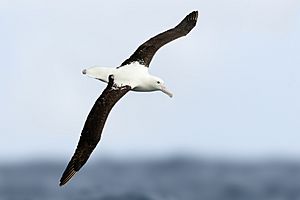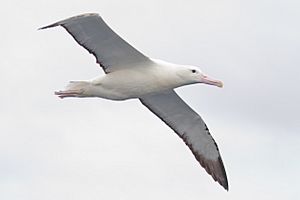Northern royal albatross facts for kids
Quick facts for kids Northern royal albatross |
|
|---|---|
 |
|
| Northern royal albatross | |
| Conservation status | |
| Scientific classification | |
| Genus: |
Diomedea
|
| Species: |
sanfordi
|
| Synonyms | |
|
Diomedea epomophora sanfordi(Murphy, 1917) |
|
The northern royal albatross or toroa is a very large seabird. It belongs to the albatross family. This amazing bird was once thought to be the same as the southern royal albatross. But in 1998, scientists decided they were different species. Some scientists still think they are just different types of the same royal albatross.
Contents
What's in a Name?
The scientific name for this albatross is Diomedea sanfordi. The word Diomedea comes from Diomedes. He was a Greek hero whose friends were said to have turned into birds. The second part, sanfordi, honors Leonard Cutler Sanford. He was an ornithologist, a scientist who studies birds. He also helped the American Museum of Natural History.
About Albatrosses and Their Family
Albatrosses are part of a bird family called Diomedeidae. This family is in a larger group called Procellariiformes. Other birds in this group include shearwaters, fulmars, and storm petrels. All these birds share some special features.
Unique Features of Albatrosses
First, they have special nasal passages. These are called naricorns and are attached to the top of their beak. Albatrosses have their nostrils on the sides of their beak.
Second, their beaks are unique. They are made of seven to nine hard plates.
Third, these birds can make a special stomach oil. This oil is stored in their stomach. They use it in two main ways. It can be sprayed at predators to protect themselves. It is also a very rich food source. Parents feed this oil to their chicks. Adults also use it for energy during their very long flights.
The northern royal albatross was first described in 1917. This was done by Robert Cushman Murphy. He studied a bird found in the Chatham Islands.
What Does the Northern Royal Albatross Look Like?
The northern royal albatross is a very big bird. It is usually about 115 centimeters (45 inches) long. It weighs between 6.2 and 8.2 kilograms (13.7 to 18.1 pounds). Its wingspan is huge, from 270 to 305 centimeters (106 to 120 inches). That's almost as wide as a small car!
Changes as They Grow
Young albatrosses have a white head, neck, and belly. Their upper back and rump are also white. They have dark spots on their head and rump. Their lower back is white with more black spots. Their upper wings are dark black-brown with white specks. Their tail is white with a black-brown tip. Their underwings are also dark. They have a black band on the front edge of their wings.
As they get older, more of their feathers turn white. Their head, back, rump, and tail become whiter. All northern royal albatrosses have a pink beak. The top part of the beak has a black cutting edge. Their legs are also pale pink.
How to Tell Them Apart
You can tell the northern royal albatross from the southern royal albatross at sea. The northern one has all dark upper wings. The southern one has large white areas on its upper wings. These two species also act differently.
Behavior of the Northern Royal Albatross
Feeding Habits
The northern royal albatross eats many different things. They feed on fish, squid, crabs, and other small sea creatures. They also eat salps, which are small, clear sea animals. Sometimes, they eat carrion, which is dead animal meat. Squid is a very important part of their diet. It can make up as much as 85% of what they eat.
Reproduction and Life Cycle
Northern royal albatrosses have special ways of finding a mate. They perform long dances together. Sometimes, many birds will display in a group. They do this in the air or on the water. Once a pair forms a strong bond, their displays become simpler.
They start breeding when they are about eight years old. They usually nest every two years. They build their nests on flat tops of islands. They like to be in grassy areas. Their nest is a low mound made of plants, mud, and feathers.
A single egg is laid in October or November. Both parents take turns sitting on the egg. This takes about 80 days. Once the chick hatches, a parent stays with it for about a month. The young bird is ready to fly after about 240 days. Their nesting areas are more crowded than those of other large albatrosses.
| Location | Population | Date | Trend |
| Chatham Islands | 6,500-7,000 pair | 2012 | Stable |
| Taiaroa Head, South Island | 60 pair | 2012 | Increasing |
| Total | 20,000 | 2012 | Stable |
Where Do Northern Royal Albatrosses Live?
Northern royal albatrosses build their nests in a few places. They nest on the Chatham Islands in New Zealand. These islands include Forty-fours Island, Big Sister Island, and Little Sister Island. They also nest on Enderby Island in the Auckland Islands. Another nesting spot is Taiaroa Head on the Otago Peninsula of New Zealand.
The colony at Taiaroa Head is special. It is the only albatross colony found on a mainland where people live in the Southern Hemisphere. When they are not breeding, these albatrosses fly all around the southern oceans. They especially like areas with the Humboldt Current and the Patagonian Shelf.
Protecting the Northern Royal Albatross
The IUCN lists the northern royal albatross as an endangered species. This means they are at high risk of becoming extinct. They live over a huge area of 64.3 million square kilometers (24.8 million square miles). But their breeding areas are very small, only about 8 square kilometers (3 square miles).
In 2012, there were an estimated 20,000 birds in total. About 6,500 to 7,000 pairs breed on the Chatham Islands each year. Another 60 pairs breed at Taiaroa Head.
Threats to Their Survival
In 1985, a series of strong storms badly damaged their main breeding grounds on the Chatham Islands. This meant there wasn't enough material for nests, which lowered their breeding success.
Chicks and eggs on the South Island have also been eaten by animals brought in by humans. These include cats, bottle flies, and stoats.
The biggest danger to these birds is longline fishing. This type of fishing uses very long lines with many hooks. Albatrosses can get caught on these hooks and drown. While efforts have been made to reduce this, it is still a threat.
What is Being Done to Help?
Many things are being done to help these birds survive.
- Scientists are putting bands on the birds' legs. This helps them track the birds and learn more about them.
- At Taiaroa Head, people control predators during the breeding season.
- There are no predators on the Chatham Islands where they breed.
- Enderby Island and Taiaroa Head are nature preserves.
- The Department of Conservation removed wild cattle, rabbits, and mice from Enderby Island by 1993.
- Scientists can now count individual birds using high-resolution satellite images.
Thanks to the work of Launcelot Eric Richdale, the colony at Taiaroa Head was protected by 1950. In 1972, people could formally visit their breeding area for the first time. Since 2001, more than 100,000 people visit the Royal Albatross Centre every year. They come to watch these amazing birds. It has become a tradition in Dunedin, New Zealand, to ring the city bells. This celebrates the first albatross to return to the Taiaroa Head colony each year.
See also
 In Spanish: Albatros real del norte para niños
In Spanish: Albatros real del norte para niños




